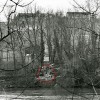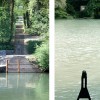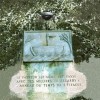Click on images to display
-

A ferry boat to carry passengers between the two banks of the river Rhône had been used at this point as early as 1782. Attached with a pulley to a ferry cable, it was operated only by the force of the current. It came to an end in 1927 with the construction of the nearby Butin Bridge.
-

The ferry reached its peak activity between 1886 and 1927 following the initiative of John Branchu, local politician and proprietor of the Café du Bac (Café of the Ferry, demolished in 1975). That is the man the commune of Vernier decided to commemorate with the creation of an art piece on the site.
-

Taking distance from the 'mercantile' use of the ferry supposed to drag café customers from the other side of the Rhône and remembering the ferryman, the crossing of a river, the currents of water and of time that inspired Herman Hesse for the beautiful pages of his novel Siddhartha, John Aldus' piece invites the passerby to, in a different way, experience the passage again, exactly at the same spot.
-

-

-

-

Two components of the original ferry remain on site: on the left bank a large concrete block presenting a metal ring and on the right bank, a free standing metallic structure. Between those elements the now absent cable guiding the boat was tightened.
-

-

-

-

A small bronze bas-relief representing the two banks, the water waves and a boat is fixed just underneath the metal ring. The artist asked the French writer Michel Butor to participate in the work writing about the idea of 'passage'. His words are engraved in the concrete block itself and read, in translation: 'The ferryman himself is bygone, With thousands of glances The ring of time shall be erased ' With the distance of 102 meters, none of those elements can be clearly seen from the other side of the river.
-

Folding Postcard from Michel Butor with the text displayed on the work.
-

-

On the right bank, a fixed telescope is placed on top of the metal structure and three steps are built to give access to the eyepiece to people of different size. Looking through the ocular, the viewer is projected to the opposite side of the river and, exactly where the ferry cable was tightened, his line of vision allows him to see, as if he or she was just front of them, the metal ring, the bas-relief and the engraved text.
-

If, facing a traditional piece of art, the spectator would have appreciated, criticised or just ignore its presence, the actuality of the telescope, in contrast strongly draws his curiosity, makes difficult to resist looking through it and, hence, invites him to spontaneously cross the river...
